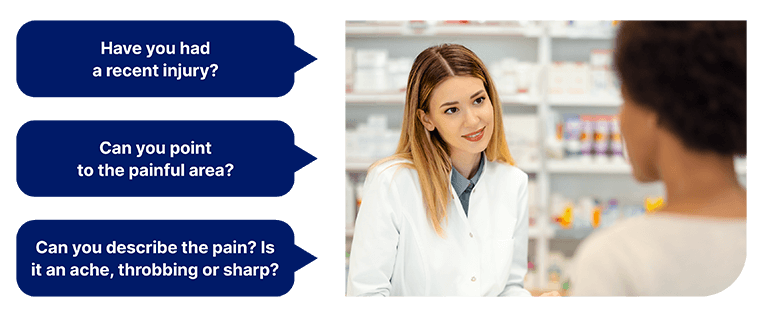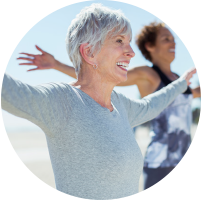Support for self-care
Muscle and joint pain is an area where the pharmacy team can encourage customers to self-care and manage their pain.

Key questions
Asking the WWHAM questions and listening carefully to your customer’s answers may help you to obtain the essential information. You can ask additional questions to gain further clarification such as:

Pharmacy teams should be aware of the symptoms of various joint and muscle conditions to help identify the type of pain and hence the most suitable course of action for the customer.

Customers may describe pain, inflammation and stiffness that stops them from moving smoothly and can affect their daily life.
They may use terms such as: grating sensation when bending the knee, pain at the base of their thumb or pain in the buttocks to describe it.
If a customer is over 45 years and has joint pain that gets worse the more they use their joints, but the stiffness in their joints is not there in the mornings, or it lasts for less than 30 minutes, they could be suffering from osteoarthritis.7

This often occurs after a strain or sprain and is particularly common in individuals aged 18–34 years.8
Sprains and strains are more common among those who play sport.1
They may describe pain, tenderness and swelling of the area; they cannot put weight on it or use it.

Often caused by a muscle strain, you can reassure customers it should improve in a few weeks.
Customers can describe aching, shooting or a burning sensation. Bending, walking or lifting can make it worse.9
If it doesn't improve within a few weeks, suggest seeking advice from a doctor.
Self-care advice
You can offer additional advice to help manage their painful condition, such as:
Strengthening and stretching activities (e.g. yoga or Pilates) can help, and they should try to build low impact exercise such as walking, swimming or cycling into their daily routine
Maintain a healthy weight to ease pressure on joints
Other ways to ease painful joints and muscles include use of heat (such as having a warm bath or applying a heat pad), ice (applying frozen peas wrapped in a tea towel) or braces and supports.
When to refer1,10,11
Refer customers to their GP if their joint, back or muscle pain:
Does not improve after treating it at home (check each individual product for details on how long it can be used for)
Gets worse or keeps coming back
Stops their day-to-day activities or hinders sleeping
Is accompanied by a high temperature and they are feeling unwell
Learning scenario
A customer who has been diagnosed with osteoarthritis
Mrs King is collecting her prescription from you when she experiences pain when bending down to pick up her shopping bag. You ask her what the problem is and she describes pain in her knee joints and stiffness, which usually happen first thing in the morning, although it does not last long.
‘I am getting old’ is her excuse.
You proceed to ask her if she has tried any medication to ease the pain?
‘No’ is her answer as she is taking lots of medicines already.
What can you do next?
Think about what you might advise, then click here for some suggestions
Mrs King is already taking lots of medicines.
This is an ideal opportunity to recommend a topical gel such as Voltarol Osteoarthritis Joint Pain Relief 1.16% Gel or Voltarol Max Strength Pain Relief 2.32% Gel, after checking with the pharmacist that there are no contraindications.
Reassure Mrs King that applying the gel directly to the joints should help ease the pain and inflammation but with low systemic absorption, meaning it may have less systemic side effects than taking tablets.
Use the pack information to show her the instructions for applying the gel and check she understands them.
You could also explore other ways to help Mrs King ease her painful joints, such as gentle exercise like swimming, yoga or walking.
